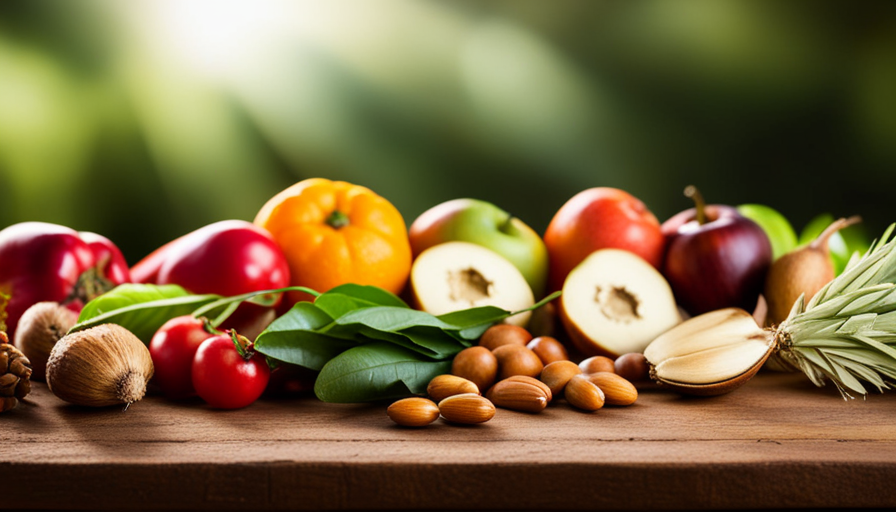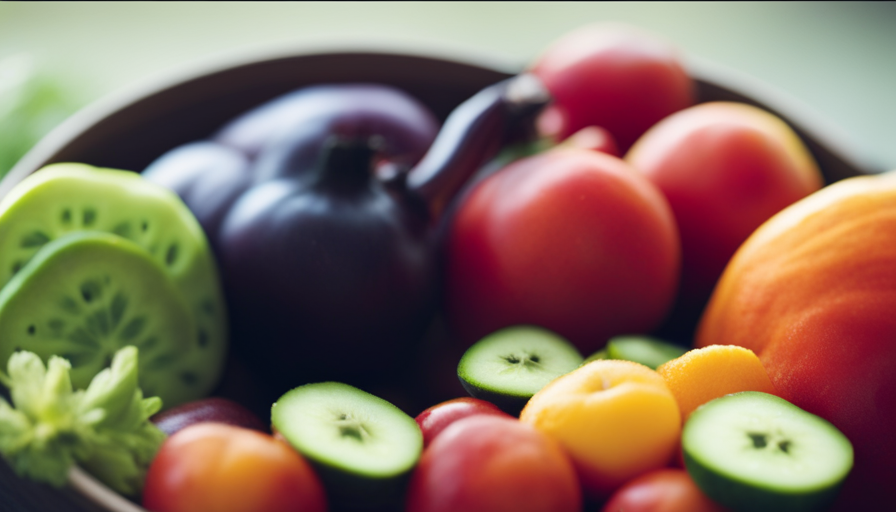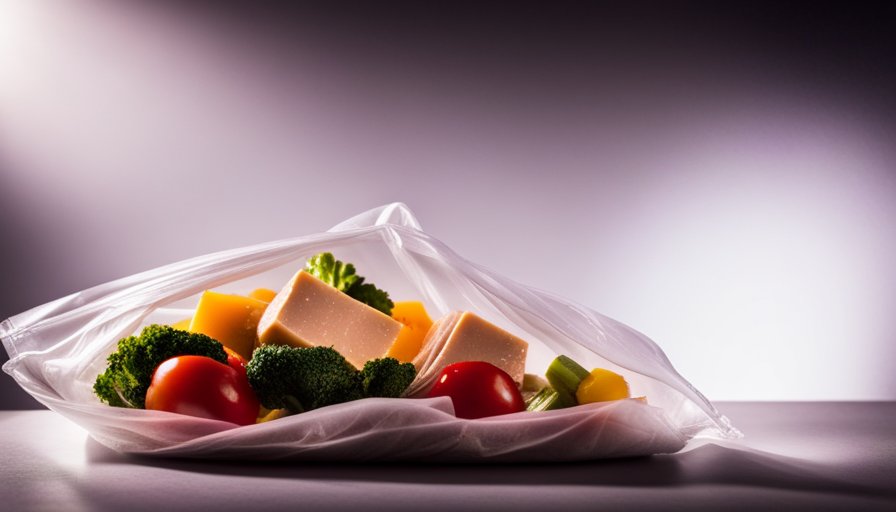Are you unsure about making the switch to a raw food diet? You might be asking yourself, ‘Why should I give up my favorite cooked meals for raw foods?’
Well, let us assure you that exploring the world of raw food can be a transformative and rewarding experience. Raw food is not just about eating cold salads and carrot sticks; it’s about embracing a lifestyle that promotes optimal health and vitality.
In this article, we will guide you through the principles of raw food, show you how to incorporate more raw fruits and vegetables into your diet, and teach you various raw food preparation techniques. We will also delve into the numerous health benefits of a raw food diet, including weight loss and detoxification.
So, if you’re ready to embark on a journey towards better health and well-being, let’s get started on your raw food adventure!
Key Takeaways
- Transition to a raw food diet gradually to make the process easier.
- Choose high-quality, organic ingredients that are vibrant in color, firm in texture, and have a fresh smell.
- Incorporate raw fruits, vegetables, nuts, and seeds into your diet for their rich vitamins, minerals, and antioxidants.
- Consider budget-friendly options such as buying in bulk, joining a local co-op, and opting for seasonal produce to save money on raw ingredients.
Understanding the Principles of Raw Food
If you’re new to the world of raw food, understanding the principles can feel like stepping into a vibrant, unexplored garden bursting with fresh, nutrient-rich possibilities.
Raw food is all about consuming unprocessed and uncooked plant-based foods, such as fruits, vegetables, nuts, and seeds. The idea behind this lifestyle is that cooking destroys essential nutrients and enzymes found naturally in these foods, so consuming them raw ensures optimal nutrition.
Transitioning to a raw food lifestyle can be a gradual process. Some people choose to go 100% raw right away, while others prefer to start incorporating more raw foods into their diet gradually. It’s important to listen to your body and find what works best for you.
Understanding the principles of raw food involves learning about the benefits it can offer. Raw foods are rich in vitamins, minerals, and antioxidants, which can support overall health and boost energy levels. They are also high in fiber, which aids in digestion and promotes a healthy gut.
When transitioning to a raw food lifestyle, it’s essential to focus on variety and balance. Include a wide range of fruits, vegetables, nuts, and seeds in your diet to ensure you’re getting all the necessary nutrients. Experiment with different recipes and techniques to keep things interesting and enjoyable.
Understanding the principles of raw food is the first step towards embracing a vibrant and nutrient-rich lifestyle. Take it slow, listen to your body, and enjoy the fresh, wholesome flavors that raw food has to offer.
Incorporating More Raw Fruits and Vegetables
To truly savor the benefits of a raw food lifestyle, it’s essential to embrace the vibrant flavors and textures of fresh fruits and vegetables. Incorporating more raw fruits and vegetables into your diet not only adds variety to your meals but also provides essential nutrients that can improve your overall health.
One way to incorporate more raw fruits and vegetables is by making raw food smoothies. These delicious and nutritious drinks are a great way to start your day or have as a snack. You can try different combinations of fruits and vegetables to find your favorite flavors. Some popular raw food smoothie recipes include green smoothies with spinach, kale, and banana, or tropical smoothies with pineapple, mango, and coconut water.
In addition to adding variety to your diet, raw fruits and vegetables are also beneficial for better digestion. They are rich in fiber, which helps to promote regular bowel movements and prevent constipation. The enzymes found in raw fruits and vegetables can also aid in the digestion process, making it easier for your body to break down and absorb nutrients.
Incorporating more raw fruits and vegetables into your diet can have numerous health benefits, from improved digestion to increased energy levels. So why not start experimenting with raw food smoothie recipes and enjoy the delicious flavors while nourishing your body?
Exploring Raw Food Preparation Techniques
Let’s dive into the world of raw food preparation techniques and unleash a burst of creativity in our culinary adventures. Raw food preparation techniques aren’t just delicious but also a great way to incorporate more nutrients into your diet.
Whether you’re looking to lose weight, maintain a healthy weight, or even gain weight, raw food can be a fantastic option.
When it comes to raw food preparation techniques, there are a multitude of options to explore. One popular technique is juicing, which allows you to extract the nutrients from fruits and vegetables in a convenient and tasty way. Another technique is blending, which can help you create smoothies that are packed with vitamins and minerals. Additionally, you can try dehydrating fruits and vegetables to create delicious and crunchy snacks.
If you’re looking to gain weight while incorporating raw food into your diet, there are plenty of options available. Avocados, nuts, and seeds are all nutrient-dense foods that can contribute to healthy weight gain. You can incorporate these foods into your meals and snacks to make sure you’re getting the necessary calories and nutrients.
Exploring raw food preparation techniques can open up a world of culinary possibilities. Whether you’re looking to lose weight, maintain a healthy weight, or gain weight, incorporating raw food into your diet can help you achieve your goals. So, get creative and start experimenting with these techniques today!
The Health Benefits of a Raw Food Diet
Explore the incredible health benefits that come with embracing a diet rich in nutrient-dense, unprocessed ingredients. When it comes to raw food, not only does it nourish your body, but it also has a positive impact on your mental health and digestion.
Raw food is known to boost mental health by providing essential nutrients that support brain function. The abundance of vitamins, minerals, and antioxidants found in raw fruits, vegetables, and nuts can help improve cognitive function, enhance mood, and reduce the risk of mental health disorders.
In addition to its mental health benefits, raw food is also great for digestion. Raw fruits and vegetables are packed with fiber, which aids in healthy digestion and prevents constipation. The enzymes present in raw foods help break down nutrients and make them easier for your body to absorb. This can improve nutrient absorption and reduce the risk of digestive issues such as bloating, gas, and indigestion.
To showcase the various health benefits of a raw food diet, take a look at the table below:
| Health Benefit | Raw Food |
|---|---|
| Mental Health | Boosts brain function and enhances mood |
| Digestion | Aids in healthy digestion and prevents constipation |
By incorporating raw food into your diet, you can nourish your body, support your mental health, and promote optimal digestion.
Finding High-Quality Raw Ingredients
Discovering top-notch raw ingredients can be like stumbling upon a treasure trove of vibrant, nutrient-packed gems. When it comes to finding high-quality raw ingredients for your raw food journey, there are a few key strategies to consider.
Firstly, explore local sources in your area. Farmers’ markets are a great place to start, as they often offer a wide variety of fresh produce straight from the farm. Not only will you be supporting local farmers, but you’ll also have the opportunity to ask questions about the growing methods used.
Another option is to grow your own ingredients. This way, you have full control over the quality and freshness of your food. Even if you don’t have a large garden, you can still grow herbs, sprouts, and microgreens on a windowsill or balcony. It’s a rewarding experience to watch your food grow from seed to plate.
When selecting ingredients, look for vibrant colors, firm textures, and a fresh smell. Avoid wilted or bruised produce, as these signs may indicate a loss of nutrients. Additionally, choose organic options whenever possible to minimize exposure to pesticides and other harmful chemicals.
By finding local sources and growing your own ingredients, you can ensure that your raw food dishes are bursting with flavor and nutritional value. Start exploring and enjoy the process of discovering the best raw ingredients for your culinary creations.
Raw Food on a Budget
If you’re looking to make the most of your money while still enjoying the benefits of a nutritious, plant-based diet, finding ways to incorporate raw ingredients into your meals can be a budget-friendly option. Raw food cost doesn’t have to break the bank, and with a little planning and creativity, you can create delicious and satisfying budget-friendly raw meals.
One cost-effective way to incorporate raw food into your diet is by buying in bulk. Look for wholesale options or join a local co-op to get access to discounted prices on raw ingredients. Buying in bulk also allows you to stock up on essentials and save money in the long run.
Another budget-friendly tip is to focus on seasonal produce. Seasonal fruits and vegetables tend to be more affordable and packed with flavor. Visit your local farmer’s market or join a community-supported agriculture (CSA) program to get access to fresh, local, and affordable produce.
Additionally, consider growing your own raw ingredients. You don’t need a large backyard to start a small herb or vegetable garden. Even a few pots on a balcony or windowsill can yield fresh produce that will save you money and provide a sense of satisfaction.
Don’t forget about the power of meal planning. By planning your meals in advance, you can make a shopping list based on the ingredients you already have and avoid unnecessary purchases. This will help you stay within your budget and reduce food waste.
Incorporating raw food into your diet doesn’t have to be expensive. By buying in bulk, focusing on seasonal produce, growing your own ingredients, and meal planning, you can enjoy budget-friendly raw meals that are both nutritious and delicious.
Raw Food for Weight Loss
When it comes to shedding those extra pounds, you’ll find that incorporating raw ingredients into your meals can be a game-changer, like biting into a crisp, refreshing salad that leaves you feeling satisfied and energized. Raw food is not only nutritious, but it can also help you achieve your weight loss goals. By focusing on whole, unprocessed foods in their natural state, you can maximize the nutritional value of your meals while minimizing calorie intake.
One great way to incorporate raw food into your diet is by trying out raw food smoothie recipes. These delicious and nutrient-packed beverages can be a satisfying meal replacement or a healthy snack option. By blending together fruits, vegetables, and superfoods like chia seeds or spinach, you can create a filling and delicious smoothie that will keep you full and satisfied throughout the day.
Another helpful tool for weight loss is following a raw food meal plan. This can help you stay on track and ensure that you are getting all the necessary nutrients while keeping your calorie intake in check. A raw food meal plan typically includes a variety of fruits, vegetables, nuts, seeds, and sprouted grains. By following this plan, you can enjoy a wide range of delicious and nutritious meals while supporting your weight loss journey.
Here is a sample raw food meal plan to help you get started:
| Meal | Recipe |
|---|---|
| Breakfast | Green smoothie: kale, spinach, banana, almond milk, and chia seeds |
| Snack | Raw veggie sticks with almond butter |
| Lunch | Zucchini noodles with marinara sauce made from fresh tomatoes and herbs |
| Snack | Fresh fruit salad |
| Dinner | Raw veggie wrap: collard greens filled with avocado, cucumber, and sprouts |
Incorporating raw food into your weight loss journey can be a great way to improve your health and achieve your goals. By trying out raw food smoothie recipes and following a raw food meal plan, you can enjoy delicious and nutritious meals while shedding those extra pounds.
Raw Food for Detoxification and Cleansing
To fully embrace the detoxifying and cleansing benefits of incorporating raw ingredients into your diet, picture yourself indulging in vibrant and nutrient-packed salads that leave your body feeling refreshed and rejuvenated.
Raw food isn’t just great for weight loss, but it also provides a natural way to detoxify and cleanse your body from the inside out. Raw food is rich in enzymes, which are essential for digestion. When you eat cooked food, the enzymes are destroyed, making it harder for your body to break down and absorb nutrients. By consuming raw food, you give your body a break from the heavy task of digesting cooked food, allowing it to focus on other important processes, like detoxification.
Raw food is also a great source of energy. When you eat raw, your body receives a high dose of vitamins, minerals, and antioxidants, which provide sustainable energy throughout the day. Cooked food, on the other hand, often lacks these nutrients due to the cooking process.
Incorporating raw food into your diet can be as simple as adding more fruits, vegetables, nuts, and seeds to your meals. You can start by having a raw salad as a side dish with your cooked meals, and gradually increase the amount of raw food you consume. Remember to choose organic and locally sourced ingredients whenever possible to maximize the benefits.
So why not give raw food a try and experience the amazing detoxifying and energizing effects it can have on your body?
Raw Food Recipes and Meal Ideas
Indulge in the vibrant and nutrient-packed salads that’ll leave your body feeling refreshed and rejuvenated with these delicious raw food recipes and meal ideas.
Raw food isn’t just beneficial for detoxification and cleansing, but also for providing essential nutrients to support overall health. Whether you’re looking to try raw food for pets or fuel your athletic performance, there are plenty of options to choose from.
For pets, raw food can provide a natural and nutritious diet. Consider incorporating raw meats, fruits, and vegetables into their meals to promote optimal health. Just make sure to consult with a veterinarian to ensure you’re meeting their specific nutritional needs.
Athletes can also benefit from raw food as it provides a high concentration of vitamins, minerals, and enzymes. Raw food meals can help enhance energy levels, improve digestion, and aid in muscle recovery. Try incorporating a variety of fresh fruits, vegetables, nuts, and seeds into your pre and post-workout meals to maximize performance and recovery.
Remember to always prioritize food safety when preparing raw meals. Wash all fruits and vegetables thoroughly and store raw meats separately to avoid cross-contamination. Enjoy the endless possibilities of raw food recipes and experience the amazing benefits it can bring to both you and your furry friends.
Overcoming Challenges and Staying Motivated
Stay motivated and overcome challenges by setting achievable goals and reminding yourself of the countless benefits that come with embracing a raw food lifestyle. It’s normal to face obstacles along the way, but with the right mindset and strategies, you can stay on track and maintain your motivation.
Here are some tips to help you stay motivated and overcome obstacles:
-
Find a support system: Surround yourself with like-minded individuals who can offer encouragement and share their own experiences. Join online communities, attend raw food meetups, or find a raw food buddy to keep you motivated.
-
Celebrate small victories: Set achievable goals and celebrate each milestone you reach. Whether it’s a week of sticking to a raw food diet or trying a new raw recipe, acknowledge your progress and reward yourself.
-
Stay educated: Continuously educate yourself about the benefits of a raw food lifestyle. Read books, watch documentaries, and follow reputable raw food blogs to stay informed and inspired.
-
Practice self-care: Taking care of your physical and mental well-being is crucial. Prioritize self-care activities like meditation, exercise, and getting enough sleep to help you stay motivated and focused.
Remember, staying motivated and overcoming obstacles is a journey. Be kind to yourself, embrace the process, and celebrate every step you take towards a healthier, raw food lifestyle.
Frequently Asked Questions
Can I still eat cooked food while following a raw food diet?
Yes, you can still enjoy cooked food while transitioning to a raw food diet. However, it’s important to remember that the goal of a raw food diet is to consume primarily unprocessed, uncooked foods. Instead of completely eliminating cooked food, try incorporating healthier alternatives such as lightly steamed vegetables or baked sweet potatoes. This way, you can gradually reduce your consumption of cooked food while embracing the benefits of a raw food lifestyle.
Is it necessary to buy all organic produce for a raw food diet?
When following a raw food diet, it isn’t necessary to buy all organic produce. While organic produce is grown without synthetic pesticides and fertilizers, conventional produce can still provide essential nutrients.
However, if you’re concerned about pesticide residues, you may choose to prioritize organic options for certain fruits and vegetables. It’s important to note that organic produce can be more expensive.
To save money, consider buying in-season produce, shopping at local farmers markets, or growing your own organic fruits and vegetables.
Are there any specific nutrients that I may be missing out on by eating only raw food?
Did you know that 100% raw food diets can lead to nutritional deficiencies?
While raw food advocates believe that cooking destroys important nutrients, the truth is that some nutrients are actually more bioavailable when cooked. For example, cooking tomatoes increases the absorption of lycopene, a powerful antioxidant.
However, this doesn’t mean that raw food is bad for you. By incorporating a variety of raw fruits, vegetables, nuts, and seeds into your diet, you can still meet your nutrient needs and enjoy the benefits of a raw food lifestyle.
How can I ensure that I am getting enough protein on a raw food diet?
To ensure you’re getting enough protein on a raw food diet, there are several ways to incorporate plant-based proteins into your meals. Opt for foods like legumes, nuts, seeds, and whole grains, which are rich sources of protein.
Additionally, you can explore alternatives to traditional sources of protein, such as tempeh, tofu, and plant-based protein powders. These options will help you meet your protein needs and maintain a balanced raw food diet.
Can I eat raw food while dining out at restaurants?
When dining out at restaurants, you can still enjoy raw food options. Look for salads, vegetable dishes, and fruit plates as these are often served raw. Ask the waiter if they can accommodate your raw food preferences and make substitutions if needed.
Remember, ‘where there’s a will, there’s a way.’ If you want to stick to a raw food diet, you can also try exploring raw food recipes and prepare your own meals at home.
What Are the Basics of Starting a Raw Food Diet?
When starting a raw food diet, it’s essential to focus on eating raw pure food to maximize its nutritional benefits. Incorporate plenty of fresh fruits, vegetables, nuts, and seeds into your meals. It’s also important to properly wash and prepare your food in order to avoid any potential contamination.
Conclusion
In conclusion, you now have a solid understanding of how to get started with raw food. By incorporating more raw fruits and vegetables into your diet and exploring different preparation techniques, you can experience the numerous health benefits that come with a raw food diet.
Remember, "Rome wasn’t built in a day," so take things one step at a time and stay motivated. With high-quality raw ingredients, you can achieve your weight loss goals and enjoy the detoxifying and cleansing effects of raw food.
Keep experimenting with delicious raw food recipes and meal ideas to keep your journey exciting and fulfilling. Stay committed, and you’ll reap the rewards of a vibrant and nourishing raw food lifestyle.










